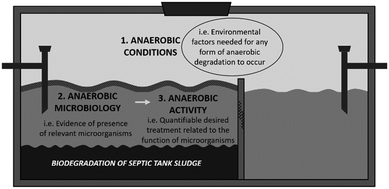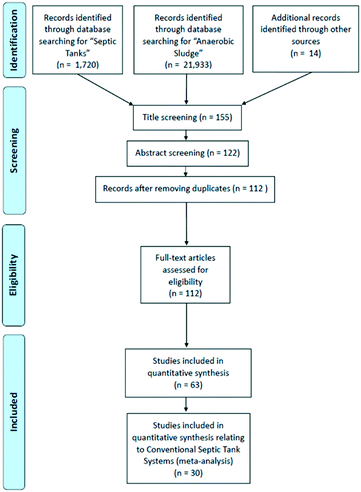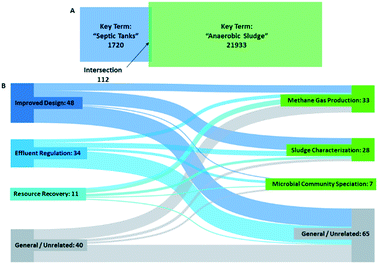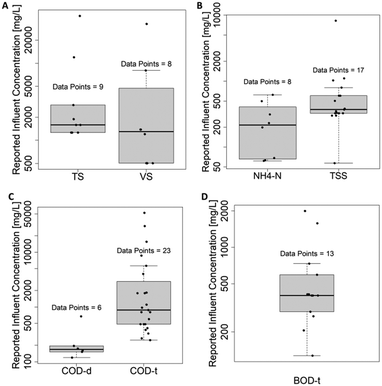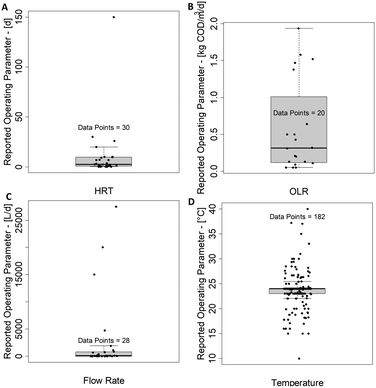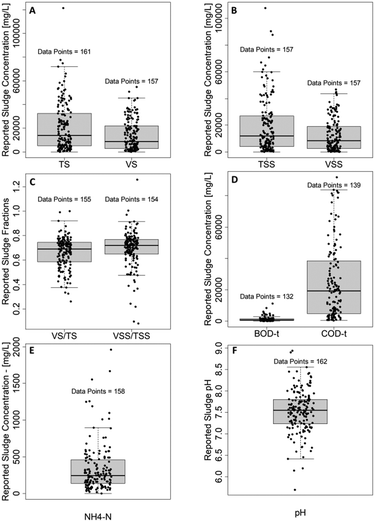Biodegradation mechanisms and functional microbiology in conventional septic tanks: a systematic review and meta-analysis
Kelsey
Shaw
 * and
Caetano C.
Dorea
* and
Caetano C.
Dorea

Department of Civil Engineering, University of Victoria, Victoria, BC, Canada. E-mail: kelseyshaw@uvic.ca
First published on 13th November 2020
Abstract
Background : Conventional septic tank (ST) systems are an important and relatively low-cost type of decentralized on-site sanitation infrastructure. Although ST systems are one of the most applied decentralized sanitation technologies globally, limited research has been performed to identify the type and degree of biodegradation mechanisms present within the tanks themselves; which are assumed to occur but have not yet been adequately characterized. Objectives: To assess available literature for evidence supporting the presence and relationship between anaerobic conditions, microbiology and activity by reviewing the current literature on the conventional ST in order to characterize the assumed anaerobic biodegradation mechanisms therein. Methods: A systematic review and meta-analysis was performed in two databases (Web of Science & Google Scholar) along with supplemental literature reporting linkages between STs and the anaerobic characterization of ST sludge. 112 records were found, of which 30 studies were retained that met the review's inclusion criteria. Results: Few studies included data on the conventional ST. Of those that did, data suggests that anaerobic conditions are present. The lack of quality and quantity in the results pertaining to anaerobic microbiology and activity raised concerns regarding the comparability and reliability of these results to accurately characterize biodegradation mechanisms. Conclusions: This review's findings support the assumption that anaerobic conditions are present in a conventional ST; however, due to the lack of robust data regarding anaerobic microbial communities and activity, it cannot be concluded that a ST is treating waste with anaerobic biodegradation processes. These findings highlight the need to further investigate the strength and effects of this relationship, especially in the context of reaching global improved- and sustainable-sanitation targets.
Water impactSeptic tanks are an important technology when it comes to meeting global safely managed sanitation targets. This study demonstrates that there are current knowledge gaps pertaining to the interaction between anaerobic conditions, microbiology and activity that characterize biodegradation mechanisms in these systems. It highlights the importance of further investigation in the context of providing sustainable solutions in the sanitation sector. |
Introduction
Effective sanitation and waste treatment systems are central to the protection of human health, preserving the natural environment and limiting technological and economic burdens to users. It is estimated that 2.3 billion people do not have access to basic sanitation systems.1 In 2016, the 17 United Nations (UN) Sustainable Development Goals (SDGs) were launched, including SDG 6: ensure access to water and sanitation for all.2 Of particular relevance are Targets:• 6.2) By 2030, achieve access to adequate and equitable sanitation and hygiene for all and end open defecation, paying special attention to the needs of women and girls and those in vulnerable situations.2
• 6.3) By 2030, improve water quality by reducing pollution, eliminating dumping and minimizing release of hazardous chemicals and materials, halving the proportion of untreated wastewater and substantially increasing recycling and safe reuse globally.2
To meet these sanitation goals there must be increased access to improved sanitation facilities that allow for the safe disposal of human excreta and urine.3 Conventional septic tank (ST) systems are one form of improved sanitation technology, as they are intended to operate as a collection, storage and treatment vessel in the faecal sludge management (FSM) chain4 on principles that minimize resource consumption (e.g. water, energy) and convert human waste to a safe output.1 ST systems have the capacity to be suitable stand-alone systems that can address basic sanitation needs and promote social and environmental sustainability where centralized sanitary sewers are unavailable or impractical. Decentralized (on-site) sanitation can be especially useful in rural and remote areas which are generally characterized by a lack of resources necessary to operate sophisticated centralized wastewater treatment plants. Globally, ST systems are amongst the most widely used household scale sewage management systems employed in the absence of centralized sewage networks.5 According to the 2019 Joint Monitoring Programme (JMP) report published by the United Nations Children's Fund (UNICEF) and the World Health Organization (WHO), of the 3.1 billion people using improved on-site sanitation facilities, 1.5 billion were using ST systems.6
It is important to note that a ST system can include both a ST and a dispersal field.7,8 However, in many contexts, most-notably in low- and middle-income countries (LMICs), this is not always the case.9–11 A ST may indeed discharge its effluent directly to the receiving environment without passing through a dispersal field.9–11 As a result of the variance of these systems and their corresponding definitions, it should be noted that this analysis is concerned primarily with the ST itself. Therefore, reference to effluent, unless otherwise specified, is the liquid discharged directly from the ST. In general, the purpose of a conventional ST has been defined as a system which can collect wastewater, separate settleable and floatable solids (sludge and scum), accumulate, consolidate and store these solids, “digest” a portion of organic particulate matter and, finally, discharge effluent, which can be further treated in a dispersal field that meets standards for the location in which it has been installed.8 Although this solids settling, sludge accumulation and assumed digestion are the most critical factors that characterize the performance of the ST, evidence of their occurrence within them is scarce. There are many benefits to improving the understanding of the relevant treatment mechanisms (i.e. degradation), specifically the assumed anaerobic (i.e. little to no free oxygen12) digestion of sludge, that may take place in STs. Although there is limited knowledge of such digestion, the available data suggests that these mechanisms are directly related to the frequency of desludging,13 biogas production14,15 and environmental pollutant control,16 as well as the level of additional treatment that is required once sludge is hauled offsite.13,17
Many of the current guidelines and regulations surrounding ST design are based solely on physical parameters such as solids retention time and storage volume,1,17,18 resulting in STs being designed for specific desludging intervals and essentially functioning as solids separation and holding tanks. The underlying biology driving treatment in a ST is poorly understood, particularly when it comes to the assumed anaerobic digestion process of solids. Many conventional STs discharge their effluent to a dispersal field7 which is typically considered to provide the secondary and final stage of treatment.7,19 However, it is possible these soil systems may be doing a considerable, though still insufficient,20 amount of contaminant abatement (i.e. nutrient and pathogen reduction)19,21 as compared to the level of treatment achieved in the tank itself (i.e. solids reduction). The lack of degradation within the ST, as evidenced by low methane (CH4) production22 and poor organic degradation (i.e. low biochemical oxygen demand (BOD) and chemical oxygen demand (COD) removal rates5,13,16), is likely a contributing factor to the widely reported soil clogging issues caused by solids accumulation in the receiving environments for these systems.23,24 This issue, when left unattended, can be detrimental to both human and environmental health due to increased solids loading and contamination of ground and surface water with pathogens and nutrients.13,16,24
Anaerobic digestion is a complex process and any understanding of its operation in a ST relies on the cascade and intersection of the specific conditions, microbiology and activity that characterize it. In view of this, the methodological framework by De Los Reyes et al25 lends itself as a useful basis to relate ST function to environmental conditions and microbial communities in order to gain a deeper mechanistic understanding of STs. Focusing on the characterization of these mechanisms, the objective of this study was to review the current literature on the conventional ST, specifically in regard to its sludge characterization. An investigation to determine the presence of anaerobic conditions and anaerobic microbiology as well as any evidence of their interaction leading to anaerobic activity and biodegradation of sludge was performed in the present systematic review and meta-analysis (Fig. 1).
Materials and methods
A systematic review was completed to examine the full scope of available evidence contained within published studies regarding the biodegradation mechanisms in a ST. This review was structured to gather practical, evidence-based results from literature to be analyzed in support of the understanding of underpinning relevant processes in a ST, specifically the processes related to anaerobic conditions, microbiology and activity.In order to be eligible for inclusion in the review for data analysis, studies were required to have findings reported in English, have been published after 1970 and before 19 May 2020 and have been an article, proceedings paper, review or book chapter. Two online databases of peer-reviewed journals, Web of Science (WoS) Core Collection and Google Scholar, were searched. Additional relevant studies were identified through searching the bibliographies of included studies. Google Scholar searches were limited to the first 200 results performed using the same search terms.
Fig. 2 summarizes search terms used and demonstrates the results of the literature search and screening. The preferred reporting items for systematic reviews and meta-analyses (PRISMA) guidelines were used as a basis for screening methodology for this study.26
To ensure study specificity, applicability and inclusivity, a preliminary screening strategy was performed. This included downloading references and performing title screening and subsequent abstract screening to determine eligibility. Titles were screened to determine which studies appropriately referred to STs with regard to anaerobic conditions, microbiology and/or activity to be selected for abstract screening. As such, the process for selecting studies to be eligible for data analysis consisted of performing an advanced search using the following terms: TS (topic) = (anaerobic sludge) and (septic tank). Subsequently, the abstract screening results indicated limited cross-over between biodegradation mechanisms in sludge (i.e. anaerobic conditions, microbiology and activity) and septic tanks, despite rising publication rates in each field separately. After removing duplicates, full texts were obtained for any article identified as having an intersection between the two fields. One reviewer then screened the full article to assess for further eligibility. Ultimately 30 papers from the 112 that were identified as intersecting both fields were selected as containing suitable and relevant data (full or partial sets) for extraction and further analysis as they pertained to a conventional ST.
For extracted parameters where ranges were reported or units differed from the ones reported in this study, average values were used, and units were converted. Results were then aggregated appropriately to summarize the characteristic parameters pertaining to a conventional ST.
Results
The results of performing an advanced search to determine the intersection between STs and anaerobic biodegradation mechanisms in sludge are summarized in Fig. 3. Studies and the data they contained were sorted for eligibility based on classification of decentralized sanitation system (Table 1). For the purpose of this study, only results pertaining to conventional ST systems, specifically the tank itself, (Fig. 4) were included in the analysis.8–11,13,14,16–19,24,27–45 These systems are the most commonly installed variant of ST systems globally and are currently poorly understood. As such, this sorting was done to eliminate as many variables as possible to better understand the mechanisms in currently installed full-scale tanks. Tank size was also considered as a parameter of importance to determine which data was from full, pilot and laboratory-scale systems (Fig. 5).| Classification | Acronym | Description | No. of studies with relevant data sets |
|---|---|---|---|
| Conventional septic tank | CST | A system consisting of one or two compartments with no other modifications. The purpose being to collect wastewater, separate settleable and floatable solids (sludge and scum) and accumulate and discharge liquid effluent10,14,27,34,46,47 | 30 |
| Modified conventional septic tank | CST-M | A system that implemented any modification to conventional design (e.g. baffled, temperature modifications, anaerobic filter, effluent filter, additional treatment, biofilter, mixer, etc.) | 14 |
| Anaerobic hybrid septic tank | AH-ST | A system that consists of a sludge bed in the lower part of the tank and an anaerobic filter in the upper part of the tank46,48 | 2 |
| Aerated septic tank | A-ST | Any system that included the intentional addition of oxygen for treatment purposes | 2 |
| Septic tank sludge | ST - sludge | Any data that was from amalgamated and undifferentiated system sources (e.g. vacuum truck, pit latrine, holding tank, etc.) | 6 |
| Continuously stirred tank reactor | CSTR | An anaerobic reactor system with a mixer; continuously stirred | 1 |
| Upflow anaerobic sludge blanket septic tank | UASB | A system that meets the design standards as set out by Lettinga et al.49 where the reactor is fed from the bottom and is typically divided into four compartments (bottom to top): the sludge bed, the fluidized zone, the gas–liquid separator; and the settling compartment | 24 |
| Modified Upflow anaerobic sludge blanket septic tank | UASB-M | A system that implemented any modifications to the UASB reactor design (e.g. temperature; post-treatment additions, etc.) | 3 |
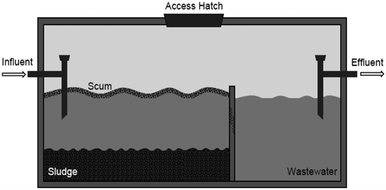 | ||
| Fig. 4 Typical configuration of a conventional septic tank; generally consists of one chamber that collects solids and one that discharges liquid effluent with T-shaped inlets/outlets and an access hatch to allow for maintenance and desludging.10,24,29,33,46,47 | ||
Parameters from selected studies were categorized as being representative of influent, sludge or effluent (prior to entering the dispersal field) quality. This distinction refers to the position in the ST system treatment chain (Fig. 4). Only reported parameters having been identified as pertaining to a conventional ST have been summarized in the following figures, and where ranges were reported, an average value was calculated. Reported parameters such as COD and BOD, if not explicitly distinguished as being soluble, particulate or total, were assumed to be total values (i.e. from samples not subject to filtration or centrifugation).
Reported influent wastewater and characteristic operating parameters are shown in Fig. 6 and 7, respectively. Reported sludge parameters and removal efficiencies as measured in ST effluent are shown in Fig. 8 and 9, respectively. Of the 30 studies selected that contained relevant data concerning conventional STs, only 2 elaborated on the microbiology present within the tanks (Fig. 10).10,16
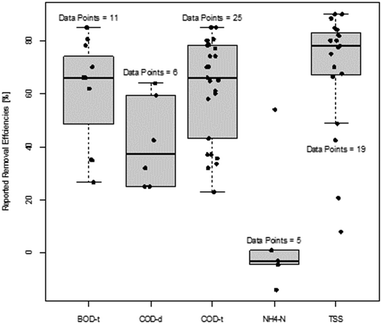 | ||
| Fig. 9 Boxplot with median concentrations of reported effluent parameter removal efficiency (bar: median; boxes; 25th and 75th percentile; whiskers 1.5 times inter-quartile range). | ||
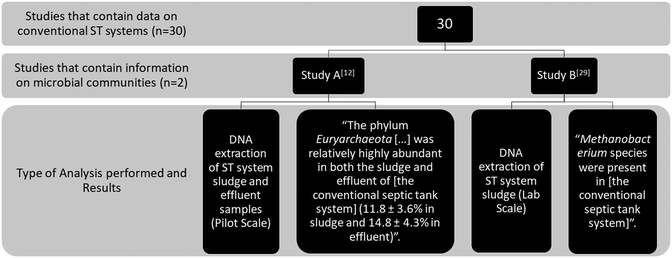 | ||
| Fig. 10 Summary of results from screened studies regarding anaerobic microbiological communities in conventional septic tank systems. | ||
Discussion
Anaerobic conditions
An anaerobic environment is one that is characterized as having little to no free oxygen.12 None of the selected studies included any data for direct dissolved oxygen (DO) measurements, except for a paper published by Taylor and Walker44 which recorded levels in their ST and effluent below 1.0 mg L−1. Levels of DO in influent household wastewater will also vary significantly based on a number of environmental factors such as temperature and the amount of organic matter present. However, in practice there are various other proxy parameters that can be used to assess if an environment is anaerobic. These include; by-products of anerobic digestion (i.e. CH4 emissions),35,50–52 carbon/nitrogen (C/N) ratios,50 and measurements of total and biodegradable organic matter (i.e. BOD, COD and VS/TS).12,50,53 These are discussed further in the Anaerobic activity section as they pertain more to evidence of activity than confirmation of the presence of conditions which could lead to activity. Additionally, there are typical conditions and defined ranges for parameters that have been found favourable or inhibitory for the development of anaerobic activity and the resulting microorganisms that are required for wastewater treatment processes in conventional municipal- and industrial-scale anaerobic reactors12,47,51,54,55 and anaerobic ponds.56,57 These conditions have been used in this analysis for comparative purposes pertaining to the confirmation of anaerobic conditions in a ST.Table 2 presents standard design parameters from literature for municipal anaerobic digesters12,51,54,55 and anaerobic ponds56,57 and their respective average ranges as compared to the reported median and averaged values and ranges for conventional STs, with specific regard to parameters that characterize sludge, obtained from the selected studies in this review.8–11,13,14,16–19,24,27–45
| Parameter | Average and recommended range for standard municipal anaerobic digesters12,51,54,55 | Average and recommended range for anaerobic ponds56,57 | Median and average reported values from literature for conventional STs8–11,13,14,16–19,24,27–45 |
|---|---|---|---|
| a Inhibitory range is reported to be between 1500–3000 mg L−1 of NH4-N (measured as N per L).51,55 | |||
| Operating temperature [°C] | 30–38 (35) | 10–25 (20) | 10–40 [24] (24) |
| OLR [kg COD per m3 d] | 0.96–4.8 (2.9) | 0.06–0.4 (0.2) | 0.05–1.94 [0.32] (0.58) |
| pH | 5–8 (6.5) | 5–8 (7) | 5.7–8.9 [7.5] (7.5) |
| HRT [d] | 10–25 (15.5) | 0.9–6.1 (3.4) | 0.2–150 [2.5] (11) |
| VS/TS | 0.5–0.8 (0.65) | Not reported (NR) | 0.26–1 [0.69] (0.66) |
| NH4-N [mg L−1] | <1500a | NR | 0.4–1963 [245] (336) |
The results presented above signify that conventional STs, described in the results section of this literature review, demonstrate conditions that align closely with those that are considered in the design of conventional municipal wastewater anaerobic digesters and anaerobic ponds, with the exception of operating temperature, which is expected due to environmental conditions. It is also worth noting the significant difference between reported median (2.5 days) and average (11 days) HRT for the STs included in literature. It is suspected that the large range in tank size (Fig. 5) coupled with variable user influent flow rates is responsible for this difference. Additionally, there is evidence which indicates a lack of nitrification (overall removal efficiency of 7%), confirming aerobic conditions are likely not favoured in these STs.58 It is also worth noting that these comparisons, although useful for demonstrative purposes, need to be contextualized. Anaerobic digesters are idealized reactors with highly controlled variables, contrary to most STs. Additionally, although anaerobic ponds function much like open STs,57 as compared to digesters, they are not widely used, especially in colder regions.56
Anaerobic microbiology
Anaerobic digestion is a complex biological process. The stability of the reaction depends on a metabolic degradation cascade and requires a diverse population of bacteria and archaea.59 Stable anaerobic digestion is accomplished by representatives of four major metabolic groups: Hydrolytic fermentative bacteria, proton-reducing acetogenic bacteria, hydrogenotrophic methanogens and acetoclastic methanogens.60 There are a variety of steps that take place in this process, but most notable is the last (fourth) step: Methanogenesis.Methanogens are part of the Euryarchaeota kingdom of which there are three principle groups: hydrogenotrophic, acetoclastic and methylotrophic.12 Hydrogenotrophs are much more robust compared to acetoclastic methanogens, and hydrogen-consuming methane production results in greater energy gains for methanogens than acetate degradation.61However, the main anaerobic digestion pathway assumed to dominate a conventional ST is the one performed by the acetoclastic archaea.12 Demonstrating this assumption, of the few studies that have made attempts at characterizing ST microbiology, the majority have focused on the genera Methanosata and Methanosarcina which are known to produce methane from acetate.62 It is worth noting, however, that many studies which include acetoclastic methanogenesis modelling have focused on alternate forms of on-site sanitation (i.e. pit latrines),62–64 not conventional ST systems, which are characterized by significantly different and arguably more difficult operating environments from a microbiological perspective. Additionally, there is evidence that hydrogenotrophic methanogens are present in the human gut,65 and consequently the feces that enters the ST.
This evidence could present a case for further investigation of alternative anaerobic digestion pathways other than acetoclastic.
The limited number of studies that examined microbiological community structures in conventional STs used methods for DNA and RNA targeted assays, including polymerase chain reaction (PCR) amplification, for analysis of microbial communities in pilot- and laboratory-scale STs at relatively high temperatures (30–48 °C).10,16 Their analysis revealed that the phylum Euryarchaeota, which contains the classes of methanogenic archaea, were present in sludge and effluent samples.10,16 Additionally, evidence was presented that supported the hypothesis that the species Methanobacterium formicicum and Methanobrevibacter were present in the laboratory-scale, temperature controlled reactors.16 Such results could indicate the presence of a microbial community that has the potential to support the degradation of organics by methanogenic anaerobic digestion. It is worth noting, however, that Methanobacterium formicicum and Methanobrevibacter were found in the reactors that were operated at elevated temperatures (40 °C),16 and although they are separate genera, they are both in the family of Methanobacteriaceae and are both considered to be hydrogenotrophic methanogens.16,66 It is important to take into account that correlation does not necessarily imply causation.25 These studies may fall into the category of ‘differential diagnosis’,67 wherein the differences in the microbial communities between control and treatment reactors are regarded as explanatory.25 It should also be stated that, based on the available evidence in this analysis, no acetoclastic methanogens were observed in conventional STs. This conclusion further weakens the assumption that there is significant acetoclastic activity happening in STs. There are gaps within the bacteriological hierarchy tree regarding species identification which would definitively confirm and differentiate hydrogenotrophic, acetoclastic and methylotrophic activity. The importance of this identification being that these species operate in different optimal temperatures and substrate ranges, which would greatly impact the functionality of a ST.68 In addition, due to the limited number of studies with relevant microbial community data, the environmental conditions (e.g. temperature range, HRT, etc.), as well as identification techniques (PCR amplification), were limited. It is important to note that the current technique employed in both studies does not differentiate whether a microorganism is dead or viable.69 Since the human gut naturally contains a number of methanogenic bacteria,65 it would be misleading to draw any conclusions based solely on their presence in ST sludge and effluent as being indicative of anaerobic activity. Both studies10,16 show successful exploratory data collection which suggests potential community interactions and this should lead to future research to gain a more fundamental understanding of the biological processes present.
As mentioned previously, there are high levels of ammonia due to a lack of nitrification and ammonia removal in STs. Additionally, there is currently no evidence in the literature evaluated as a part of this study, that anammox reactions (the process of producing nitrogen gas under anaerobic conditions) and the organisms responsible for these reactions,70 exist in a conventional ST. This was expected given the fact that anammox organisms are characteristically even slower growing70 than acetoclastic methanogens, whose presence was not supported by evidence evaluated in this study. These findings further emphasize the need to investigate the functioning anaerobic microbial environment as a product of a ST's operating conditions.
It is clear that observation of the microbiology in a conventional ST remains scarce relative to the wealth of literature on industrial-scale anaerobic digesters.10 The microbiology related to process performance, including the identification of organisms which would indicate optimal and failing performance, must first be understood, before any improvements or optimization can be made on ST design. Characterizing the variability in the microbiology underlying the processes that occur in the ST may allow for predictions of when current and future technologies will operate within acceptable bounds. Additionally, there is a need to determine if microbial communities present in sludge are governed by intrinsic characteristics, ST operation or a combination of both.
Anaerobic activity
An important parameter and component of the conventional ST system treatment chain is sludge accumulation. Typically, the sedimentation and accumulation of sludge is associated with the assumed anaerobically dominated biological treatment stage of the influent wastewater.11,13,16–18,27,29,30,32,34–39,41,43,45 The production of sludge in any wastewater treatment application is related to the amount of settleable solids in the influent wastewater in soluble, particulate, organic and inorganic forms.12,53 Sludge is commonly quantified with reference to analyses of TS, VS, TSS, VSS, total COD and particulate COD.12,53 Anaerobic microorganisms require readily biodegradable organic compounds to function.12,53 In general, particulate COD is regarded as the major contributing organic energy source for anaerobic activity to occur,12 and there exists a relationship between the VS value and particulate COD (1.42–1.48 kg COD per kg VS).12,53 As such, it was important in this study to quantify and delineate measurements taken in conventional STs with respect to these parameters. It would be expected that with anaerobic activity the conversion of COD, specifically particulate COD, to CH4 and CO2, would account for a significant portion of observed COD removal efficiency. However, a significant limitation to most studies was that they did not specify which COD fraction they were reporting, or only total COD was measured and reported. Additionally, many studies did not have the appropriate paired data sets to further explore this relationship. Table 3 demonstrates results from the only two studies10,39 that contained paired data sets that reflected influent and effluent conditions for both total and particulate COD as well as an indication of total solids fractions.| Study | Type | Total COD | Particulate COD fraction | Total solids | Total COD | Particulate COD fraction | Total solids |
|---|---|---|---|---|---|---|---|
| a Total suspended solids – total solids was not reported however the trend of overall reduction in solids can be demonstrated with this parameter. | |||||||
| Connelly et al., 2019 (ref. 10) | Installed pilot-scale household ST | 1823 mg L−1 | 63% | 1895 mg L−1 | 534 mg L−1 (71%) | 58% | 967 mg L−1 (49%) |
| Lin et al., 2019 (ref. 39) | Controlled simulated lab-scale ST – control ST fed with sewage only | 599 mg L−1 | 80% | 382 mg L−1a | 130 mg L−1 | 48% | 70 mg La (82%) |
| Lin et al., 2019 (ref. 39) | Controlled simulated lab-scale ST – experiment ST fed with sewage and food waste | 876 mg L−1 | 78% | 501 mg La | 172 mg L−1 (80%) | 54% | 77 mg La (85%) |
Table 3 demonstrates that the particulate fraction of influent and effluent COD remains relatively constant in the pilot-scale ST even with the overall decrease (i.e. removal efficiency) in total COD. Conversely, in the simulated lab-scale STs, where anaerobic conditions and activity could be easily achieved and monitored, there is a noticeable decrease in particulate COD as well as total COD. These results could indicate that the removal of total COD in the pilot-scale ST could be primarily attributed to the physical treatment (i.e. settling) that is occurring and not due to treatment provided by anaerobic activity within the tank. It should be noted, however, that this is a very limited data set. Ideally, paired data sets from multiple studies, test locations and STs with a greater number of parameters (i.e. methane production rates, VS, BOD, etc.), as well as measurements that characterized sludge in the tank, would be able to further expand this analysis. Without the further development of standardized analytical and reporting procedures, the exchange of knowledge on this topic will not improve.
The impact of effective anaerobic degradation in a conventional ST on the receiving environment can be characterized by the ability of the dispersal field to treat the effluent it is receiving from the tank, if one exists. If a dispersal field is receiving increased levels of solids (i.e. total solids, particulate COD, etc.) it can overload the field and partially inhibit any treatment that could be occurring there. Comparing values obtained from literature in this review that characterize effluent leaving the ST dispersal field and entering the receiving environment to effluent standards show that the treatment effectiveness of the conventional ST is likely a contributing factor impeding the dispersal field from operating properly and inhibiting treatment (Table 4). It can be argued that these exceedances can be attributed, in part, to the lack of understanding regarding the degree and type of anaerobic activity occurring within these systems, which is ultimately leading to their misuse in contexts where environmental and physical operating parameters are not suited to their treatment capabilities.
| Effluent parameters from selected studies8–11,13,14,16–19,24,27–45 [median] (averages) | Effluent standard thresholds and compliance | ||||
|---|---|---|---|---|---|
| ISO effluent performance threshold (minimum)1 | ISO effluent performance threshold (maximum)1 | ||||
| COD (Total) | [168] 346 mg L−1 | 50 mg L−1 | 0% | 150 mg L−1 | 0% |
| TSS | [70] 1951 mg L−1 | 10 mg L−1 | 0% | 30 mg L−1 | 0% |
Another parameter typically associated with quantifying anaerobic activity is biogas production, specifically CH4 production.8,10,13,14,16,18,19,27,30–35,37–43,45 Average and median reported values of CH4 production from selected studies that investigated conventional STs reported 139 L CH4 per kg and 157 L CH4 per kg COD removed, respectively.13,14,16,35,37,42,43 Although operating parameters such as temperature and HRT can significantly impact CH4 production rates,10,16–18,24,31,36,45 comparing this value to that of a typical municipal anaerobic digester (350 L kg−1 COD removed)12 demonstrates that there may be other factors that are hindering or controlling anaerobic activity within a conventional ST. These results are of particular interest as they pertain to the potential usage of experimental data to determine the contribution that conventional ST systems make globally to greenhouse gas (GHG) emissions. A study completed by Diaz et al.22 has shown that current, widely used estimates, such as the methane emissions factors in the Intergovernmental Panel on Climate Change (IPCC) National Greenhouse Gas Inventory Methodology,71 are likely overestimating GHG emission contributions from STs. It is important that a possible overestimation of GHG emissions as a result of a lack of understanding of the underpinning mechanisms does not become a barrier to implementing basic and extremely scalable improved forms of sanitation.72
This meta-analysis and literature review confirmed previous claims that there is significant variability in the quality and strength of influent wastewater in conventional ST systems and that this influent is generally more concentrated in particulate, soluble, inorganic and organic parameters than municipal wastewater. There is evidence that, on average, conventional ST conditions are present which could allow for anaerobic activity to occur. The data, however, suggests that a broader survey of a greater number of conventional full-scale STs over a longer time period could reveal important information regarding anaerobic activity and indicator microbes associated with both treatment efficiency and effluent water quality. Paired indices could be identified to add confidence if these were to be used as monitoring parameters. It is clear, given the lack of data on sludge as compared to influent and effluent parameters, that sampling and analysis are arduous; there is a need for simple, cost-effective sampling equipment that can be used in the field which would make compiling important data sets more accessible in resource-constrained contexts.
Although a considerable body of research exists to improve ST design and operation, there is still a pressing need to accurately characterize the processes that are inherent to its conventional design. As one of the most popular and accessible forms of decentralized sanitation globally,5,6 there are significant benefits to being able to close these data gaps. More accessible monitoring and sampling equipment and the ability to produce robust data sets will aid in determining the extent of anaerobic microbiology and activity present in a conventional ST. This type of information can be used to gauge the sustainability (e.g. GHG emissions) and effectiveness (with regards to treatment objectives) of these systems that are providing a basic form of improved sanitation globally.
Limitations
General limitations for this review may include study selection, as although this review was conducted using a comprehensive search strategy along with specific inclusion criteria, expanding the selection to more than two databases (i.e. WoS and Google Scholar) could have yielded additional results. Only results from the database search in English and those reported prior to 19 May 2020 were included, therefore it is possible that a relevant study published in another language or after the completion of the selection exists. In an effort to limit the effect of outlying data points without excluding them from the analysis entirely, median and average values were calculated and reported when possible. However, in some instances average values were used to represent data from studies that reported ranges which could inaccurately represent the spread of the data and may be impacted by outliers in those respective data sets. As previously discussed, a major limitation encountered in this analysis was that many studies did not distinguish between particulate and total COD and BOD values. This limited the capability to estimate accurate organic loading in many of the STs. Synthesized and summarized information in this review is subject to author's interpretation and may not reflect evidence beyond its intended scope.Conclusions
The objective of this work was to review the current literature on conventional ST systems in order to better characterize the assumed biodegradation mechanisms that occur in accumulated sludge within the tanks of these systems. This work used a systematic approach to gather and aggregate data from previous studies with regard to anaerobic conditions, microbiology and activity. The above analysis provides evidence that anaerobic conditions exist in conventional STs. Although there is substantial evidence of anaerobic conditions, there is not enough evidence to definitively confirm anaerobic microbiology or anaerobic activity. Therefore, it cannot be concluded that a conventional ST is providing treatment through the biodegradation mechanisms associated with anaerobic activity. This is based on the aggregated results for specific parameters, typically used to measure treatment efficiency and effectiveness, either demonstrating underperformance or not having been measured at all. Adding to this uncertainty is a lack of microbial community analysis and the degree of specificity that the limited analysis provided.This data is useful in identifying the current gap in knowledge that exists surrounding this popular form of decentralized sanitation. The continuation of this work regarding the accurate and detailed characterization of the microbial community and resulting activity present within a conventional ST will contribute to a body of knowledge that can work to promote access to simple, effective and sustainable sanitation solutions. This is a timely exercise that will aid the continued expansion and simultaneous improvement of the conversation surrounding improved sanitation strategies in resource constrained and remote settings, as set out in Target 6 of the SDGs.
Conflicts of interest
There are no conflicts to declare.Acknowledgements
This study was funded through a British Columbia Provincial Graduate Scholarship provided through the issuing institution (University of Victoria) and a Natural Sciences and Engineering Research Council (Canada, NSERC) Canadian Graduate Scholarships-Master's (CGS-M).Notes and references
- ISO, International Standard ISO 30500: Non-sewered sanitation systems - Prefabricated integrated treatment units - general safety and performance requirements for design and testing, ISO, 2018 Search PubMed.
- United Nations (UN), Transforming our World: the 2030 Agenda for Sustainable Development, UN General Assembly, 2015 Search PubMed.
- World Health Organization and United Nations Children's Fund (WHO & UNICEF), Joint Monitoring programme for water supply and sanitation, https://washdata.org/data/household#!/dashboard/new, (accessed 19 May 2020) Search PubMed.
- L. Strande, M. Ronteltap and D. Brdjanovic, Faecal Sludge Management – Systems Approach for Implementation and Operation, IWA Publishing, 2014 Search PubMed.
- P. J. Withers, P. Jordan, L. May, H. P. Jarvie and N. E. Deal, Do septic tank systems pose a hidden threat to water quality?, Front. Ecol. Environ., 2014, 12, 123–130 CrossRef.
- United Nations Children's Fund (UNICEF) and World Health Organization (WHO), Progress on household drinking water, sanitation and hygiene 2000–2017, Special Focus on Inequalities, New York, 2019 Search PubMed.
- A. M. Truhlar, K. L. Ortega and M. T. Walter, Seasonal and diel variation in greenhouse gas emissions from septic system leach fields, Int. J. Environ. Sci. Technol., 2019, 16, 6043–6052 CrossRef CAS.
- T. R. Bounds, Design and Performance of Septic Tanks, Site Characterization and Design of On-Site Septic Systems, ASTM STP 1324, 1997 Search PubMed.
- M. Englund, J. P. Carbajal, V.-A. Nguyen and L. Strande, Modelling quantities and qualities (Q&Q) of faecal sludge in Hanoi, Vietnam and Kampala, Uganda for improved management solutions, J. Environ. Manage., 2020, 13 Search PubMed.
- S. Connelly, T. Pussayanavin, R. J. Randle-Boggis, A. Wicheansan, S. Jampathong, C. Keating, U. Z. Ijaz, W. T. Sloan and T. Koottatep, Solar Septic Tank: Next Generation Sequencing Reveals Effluent Microbial Community Composition as a Useful Index of System Performance, Water, 2019, 11, 2660 CrossRef CAS.
- L. Strande, L. Schoebitz, F. Bischoff, D. Ddiba, F. Okello, M. Englund, B. J. Ward and C. B. Niwagaba, Methods to reliably estimate faecal sludge quantities and qualities for the design of treatment technologies and management solutions, J. Environ. Manage., 2018, 223, 898–907 CrossRef CAS.
- G. Tchobanoglous, F. L. Burton and H. D. Stensel, Wastewater Engineering: Treatment and Reuse, Metcalf & Eddy Inc., McGraw Hill, 4th edn, 2003 Search PubMed.
- T. Koottatep, S. K. Chapagain, C. Polprasert, A. Panuvatvanich and K.-H. Ahn, Sanitation situations in selected Southeast Asian countries and application of innovative technologies, Environ. Dev. Sustain., 2018, 20, 495–506 CrossRef.
- C. Zamalloa, J. B. A. Arends, N. Boon and W. Verstraete, Performance of a lab-scale bio-electrochemical assisted septic tank for the anaerobic treatment of black water, New Biotechnol., 2013, 30, 573–580 CrossRef CAS.
- T. Elmitwalli, Yucheng Feng, Joachim Behrendt and Ralf Otterpohl, Anaerobic digestion potential for ecological and decentralized sanitation in urban areas, Water Sci. Technol., 2006, 53, 45–54 CrossRef CAS.
- T. Pussayanavin and T. Koottatep, Rawintra Eamrat and Chongrak Polprasert, Enhanced sludge reduction in septic tanks by increasing temperature, J. Environ. Sci. Health, Part A: Toxic/Hazard. Subst. Environ. Eng., 2015, 50, 81–89 CrossRef CAS.
- H. Lossing, P. Champagne and P. James McLellan, Examination of sludge accumulation rates and sludge characteristics for a decentralized community wastewater treatment systems with individual primary clarifier tanks located in Wardsville (Ontario, Canada), Water Sci. Technol., 2010, 62, 2944–2952 CrossRef CAS.
- H. Philip, S. Maunoir, A. Rambaud and L. S. Philippi, Septic Tank Sludges: Accumulation Rate and Biochemical Characteristics, Water Sci. Technol., 1993, 28, 57–64 CrossRef CAS.
- S. R. Wilhelm, Sherry L. Schiff and John A. Cherry, Biogeochemical Evolution of Domestic Waste Water in Septic Systems: 1. Conceptual Model, Ground Water, 1994, 32, 905–916 CrossRef CAS.
- H. M. Murphy, S. McGinnis, R. Blunt, J. Stokdyk, J. Wu, A. Cagle, D. M. Denno, S. Spencer, A. Firnstahl and M. A. Borchardt, Septic Systems and Rainfall Influence Human Fecal Marker and Indicator Organism Occurrence in Private Wells in Southeastern Pennsylvania, Environ. Sci. Technol., 2020, 54, 3159–3168 CrossRef CAS.
- C. D. Beal, E. A. Gardner and N. W. Menzies, Process, performance, and pollution potential: A review of septic tank - soil absorption systems, Soil Res., 2005, 43, 781 CrossRef.
- L. R. Diaz-Valbuena, H. L. Leverenz, C. D. Cappa, G. Tchobanoglous, W. R. Horwath and J. L. Darby, Methane, Carbon Dioxide, and Nitrous Oxide Emissions from Septic Tank Systems, Environ. Sci. Technol., 2011, 45, 2741–2747 CrossRef CAS.
- J. Tomaras, J. W. Sahl, R. L. Siegrist and J. R. Spear, Microbial Diversity of Septic Tank Effluent and a Soil Biomat, Appl. Environ. Microbiol., 2009, 75, 3348–3351 CrossRef CAS.
- L. Keshtgar, A. Rostami, A. A. Azimi, M. Dehghani and S. Ataolahi, The impact of barrier walls (baffle) on performance of septic tanks in domestic wastewater treatment, Desalin. Water Treat., 2019, 161, 254–259 CrossRef CAS.
- F. L. De Los Reyes, J. E. Weaver and L. Wang, A methodological framework for linking bioreactor function to microbial communities and environmental conditions, Curr. Opin. Biotechnol., 2015, 33, 112–118 CrossRef CAS.
- D. Moher, A. Liberati, J. Tetzlaff, D. G. Altman and PRISMA Group, Preferred reporting items for systematic reviews and meta-analyses: the PRISMA statement, PLoS Med., 2009, 6, e1000097 CrossRef.
- F. Al Momani, Mathematical model for predicting sludge accumulation in septic tanks based on operational parameters: effect of hydraulic mixing: Predicting sludge accumulation in septic tanks, Water Environ. J., 2015, 29, 499–506 CrossRef.
- M. P. Alderson, A. B. dos Santos and C. R. Mota Filho, Reliability analysis of low-cost, full-scale domestic wastewater treatment plants for reuse in aquaculture and agriculture, Ecol. Eng., 2015, 82, 6–14 CrossRef.
- F. Almomani, Field study comparing the effect of hydraulic mixing on septic tank performance and sludge accumulation, Environ. Technol., 2016, 37, 521–534 CrossRef CAS.
- M. Brandes, Accumulation Rate and Characteristics of Septic Tank Sludge and Septage, J. - Water Pollut. Control Fed., 1978, 50, 936–943 CAS.
- Z. Chen, Q. Wen, H. Guan, R. Bakke and N. Ren, Anaerobic treatment of domestic sewage in modified septic tanks at low temperature, Environ. Technol., 2014, 35, 2123–2131 CrossRef CAS.
- J. Diak, B. Örmeci and K. J. Kennedy, Effect of micro-aeration on anaerobic digestion of primary sludge under septic tank conditions, Bioprocess Biosyst. Eng., 2013, 36, 417–424 CrossRef CAS.
- S. Fach and S. Fuchs, Design and development of decentralized water and wastewater technologies: A combination of safe wastewater disposal and fertilizer production, Water Sci. Technol., 2010, 62, 1580–1586 CrossRef CAS.
- F. Fdz-Polanco, S. I. Pérez-Elvira and M. Fdz-Polanco, Present and perspectives of anaerobic treatment of domestic sewage, Desalin. Water Treat., 2009, 4, 161–167 CrossRef CAS.
- M. Gao, L. Zhang, B. Guo, Y. Zhang and Y. Liu, Enhancing biomethane recovery from source-diverted blackwater through hydrogenotrophic methanogenesis dominant pathway, Chem. Eng. J., 2019, 378, 122258 CrossRef CAS.
- N. F. Gray, The Influence of Sludge Accumulation Rate on Septic Tank Design, Environ. Technol., 1995, 16, 795–800 CrossRef CAS.
- L. Korsak and L. Moreno, Evaluation of anaerobic sludge activity in wastewater treatment plants in Nicaragua, 2006, vol. 95 Search PubMed.
- K. Kujawa-Roeleveld and G. Zeeman, Anaerobic Treatment in Decentralised and Source-Separation-Based Sanitation Concepts, Rev. Environ. Sci. Biotechnol., 2006, 5, 115–139 CrossRef CAS.
- H. Lin, Y. Wang, L. van Lierop, C. Zamalloa, C. Furlong, M. Keleman and B. Hu, Study of food waste degradation in a simulated septic tank, Waste Manage. Res., 2019, 37, 1199–1206 CrossRef.
- S. P. Lohani, R. Bakke and S. N. Khanal, A septic tank-UASB combined system for domestic wastewater treatment: a pilot test, Water Environ. J., 2015, 29, 558–565 CrossRef.
- S. Maunoir, H. Philip and A. Rambaud, Small Wastewater Treatment Plants in Mountain Areas: Combination of Septic Tank and Biological Filter, Water Sci. Technol., 2007, 56, 65–71 CrossRef CAS.
- L. O. Prado, H. H. S. Souza, G. M. Chiquito, P. L. Paulo and M. A. Boncz, A comparison of different scenarios for on-site reuse of blackwater and kitchen waste using the life cycle assessment methodology, Environ. Impact Assess. Rev., 2020, 82, 106362 CrossRef.
- T. Schalk, J. Effenberger, A. Jehmlich, J. Nowak, H. Rustige, P. Krebs and V. Kühn, Methane oxidation in vertical flow constructed wetlands and its effect on denitrification and COD removal, Ecol. Eng., 2019, 128, 77–88 CrossRef.
- A. A. Taylor and S. L. Walker, Effects of copper particles on a model septic system's function and microbial community, Water Res., 2016, 91, 350–360 CrossRef CAS.
- H. Wang, S. Zhu, B. Qu, Y. Zhang and B. Fan, Anaerobic treatment of source-separated domestic bio-wastes with an improved upflow solid reactor at a short HRT, J. Environ. Sci., 2018, 66, 255–264 CrossRef.
- T. Elmitwalli, Sludge accumulation and conversion to methane in a septic tank treating domestic wastewater or black water, Water, 2013, 68, 956–964 CAS.
- N. Okafor, in Environmental Microbiology of Aquatic and Waste Systems, Springer Netherlands, Dordrecht, 2011, pp. 249–273 Search PubMed.
- N. Mahmoud and J. B. Van Lier, Enhancement of a UASB-septic tank performance for decentralised treatment of strong domestic sewage, Water Sci. Technol., 2011, 64, 923–929 CrossRef CAS.
- G. Lettinga and L. W. Hulshoff Pol, UASB-Process Design for Various Types of Wastewaters, Water Sci. Technol., 1991, 24, 87–107 CrossRef CAS.
- J. N. Meegoda, B. Li, K. Patel and L. B. Wang, A Review of the Processes, Parameters, and Optimization of Anaerobic Digestion, Int. J. Environ. Res. Public Health, 2018, 15, 2224 CrossRef CAS.
- E. J. Chaggu, W. Sanders and G. Lettinga, Demonstration of anaerobic stabilization of black water in accumulation systems under tropical conditions, Bioresour. Technol., 2007, 98, 3090–3097 CrossRef CAS.
- P. Chatterjee, M. M. Ghangrekar and S. Rao, Biogas Production from Partially Digested Septic Tank Sludge and its Kinetics, Waste Biomass Valorization, 2019, 10, 387–398 CAS.
- P. Foladori, G. Andreottola and G. Ziglio, Sludge Reduction Technologies in Wastewater Treatment Plants, IWA Publishing, 2010 Search PubMed.
- A. Costa, C. Ely, M. Pennington, S. Rock, C. Staniec and J. Turgeon, Anaerobic Digestion and its Applications, U.S. Environmental Protection Agency, Washington, DC, USA, 2015 Search PubMed.
- P. L. McCarty and R. E. McKinney, Salt Toxicity in Anaerobic Digestion, J. - Water Pollut. Control Fed., 1961, 33, 399–415 CAS.
- Principles of Design and Operations of Wastewater Treatment Pond Systems for Plant Operators, Engineers, and Managers, US EPA, 2011 Search PubMed.
- D. D. Mara, Domestic wastewater treatment in developing countries, Earthscan Publications, London, Sterling, VA, 2004 Search PubMed.
- W. K. Dodds, A. J. Burgin, A. M. Marcarelli and E. A. Strauss, Chapter 32 - Nitrogen Transformations, Academic Press, 3rd edn, 2017 Search PubMed.
- B. Schink, Energetics of syntrophic cooperation in methanogenic degradation, Microbiol. Mol. Biol. Rev., 1997, 61, 262–280 CAS.
- C. Cavinato, A. Ugurlu, I. de Godos, E. Kendir and C. Gonzalez-Fernandez, in Microalgae-Based Biofuels and Bioproducts, ed. C. Gonzalez-Fernandez and R. Muñoz, Woodhead Publishing, 2017, pp. 155–182 Search PubMed.
- U. von Stockar, T. Maskow, J. Liu, I. W. Marison and R. Patiño, Thermodynamics of microbial growth and metabolism: An analysis of the current situation, J. Biotechnol., 2006, 121, 517–533 CrossRef CAS.
- B. Torondel, Sanitation Ventures Literature Review: on-site sanitation waste characteristics, London School of Hygiene and Tropical Medicine, London, UK, 2010 Search PubMed.
- M. H. A. van Eekert, W. T. Gibson, B. Torondel, F. Abilahi, B. Liseki, E. Schuman, C. Sumpter and J. H. J. Ensink, Anaerobic digestion is the dominant pathway for pit latrine decomposition and is limited by intrinsic factors, Water Sci. Technol., 2019, 79, 2242–2250 CrossRef CAS.
- C. Brouckaert, K. Foxon and K. Wood, Modelling the filling rate of pit latrines, Water SA, 2013, 39, 555–562 Search PubMed.
- N. Gaci, G. Borrel, W. Tottey, P. W. O'Toole and J.-F. Brugère, Archaea and the human gut: New beginning of an old story, World J. Gastroenterol., 2014, 20, 16062 CrossRef CAS.
- D. Z. Sousa, A. F. Salvador, J. Ramos, A. P. Guedes, S. Barbosa, A. J. M. Stams, M. M. Alves and M. A. Pereira, Activity and Viability of Methanogens in Anaerobic Digestion of Unsaturated and Saturated Long-Chain Fatty Acids, Appl. Environ. Microbiol., 2013, 79, 4239–4245 CrossRef CAS.
- F. L. De Los Reyes, Challenges in determining causation in structure–function studies using molecular biological techniques, Water Res., 2010, 44, 4948–4957 CrossRef CAS.
- J. R. Leadbetter, L. D. Crosby and J. A. Breznak, Methanobrevibacter filiformis sp. nov., a filamentous methanogen from termite hindguts, Arch. Microbiol., 1998, 169, 287–292 CrossRef CAS.
- G. A. Cangelosi and J. S. Meschke, Dead or Alive: Molecular Assessment of Microbial Viability, Appl. Environ. Microbiol., 2014, 80, 5884–5891 CrossRef.
- B.-L. Hu, L.-D. Shen, X.-Y. Xu and P. Zheng, Anaerobic ammonium oxidation (anammox) in different natural ecosystems, Biochem. Soc. Trans., 2011, 39, 1811–1816 CrossRef CAS.
- IPCC, 2019 Refinement to the 2006 IPCC Guidelines for National Greenhouse Gas Inventories, IPCC, Switzerland, 2019 Search PubMed.
- C. Bourgault, K. Shaw and C. C. Dorea, Dominant decomposition pathways in pit latrines: a commentary, Water Sci. Technol., 2019, 80, 1392–1394 CrossRef CAS.
| This journal is © The Royal Society of Chemistry 2021 |

